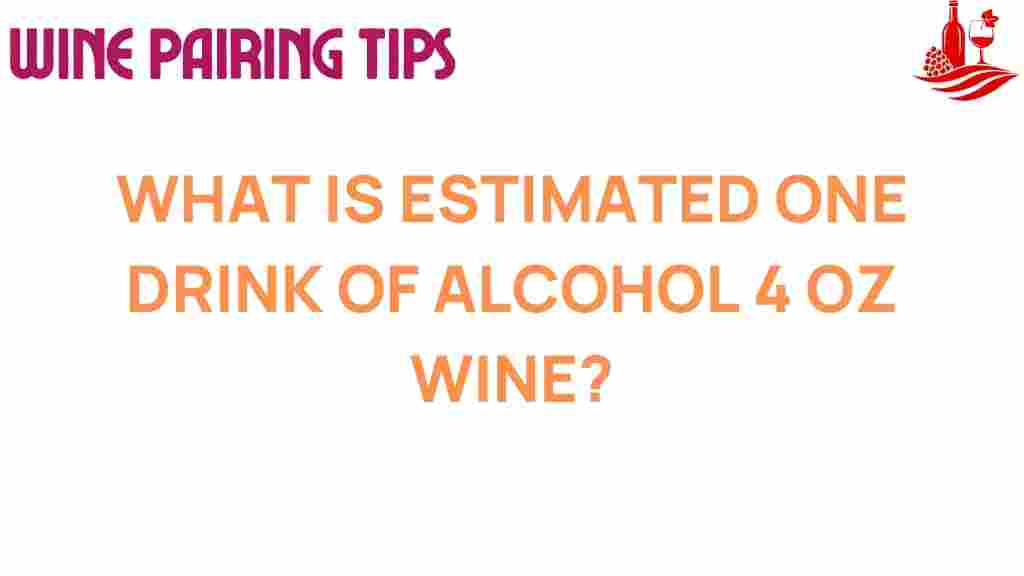Unveiling the Truth: Alcohol Content in a 4 oz Glass of Wine
Wine is one of the most popular alcoholic beverages worldwide, enjoyed in various settings from casual dinners to formal celebrations. However, understanding the alcohol content in wine, especially in a standard serving size like a 4 oz glass, is crucial for responsible drinking. In this article, we will delve into how much alcohol is typically present in this serving size, the importance of wine measurements, and guidelines for drinking wine responsibly.
The Basics of Wine Serving Size
When it comes to wine, serving sizes can vary greatly depending on the type of wine and how it’s served. A common serving size of wine is 5 oz, but many people prefer a smaller pour, such as a 4 oz glass. Understanding the wine serving size is essential for managing alcohol intake.
- 4 oz wine: A smaller pour that allows for better control of alcohol consumption.
- 5 oz wine: The typical serving size used in restaurants and bars.
- 6 oz wine: Often seen in larger glasses or for more generous pours.
Understanding Alcohol Content
The alcohol content of wine is expressed as a percentage of alcohol by volume (ABV). This percentage indicates how much of the liquid is made up of alcohol. On average, most wines have an ABV ranging from 12% to 15%. However, some wines can have a significantly higher or lower ABV, which affects how much alcohol is in a 4 oz serving.
Calculating Alcohol Content in a 4 oz Glass of Wine
To determine the amount of alcohol in a 4 oz glass of wine, you can use the following formula:
Alcohol Content (in oz) = (ABV/100) * Serving Size (in oz)
For example, if you pour a 4 oz glass of wine with an ABV of 12%, the calculation would be:
(12/100) * 4 oz = 0.48 oz of alcohol
Conversely, if the wine has a higher ABV, say 15%, the calculation would be:
(15/100) * 4 oz = 0.60 oz of alcohol
Wine Measurement and Its Importance
Accurate wine measurement is essential for understanding your alcohol intake. Knowing how much alcohol is in your glass can help you make informed decisions about consumption. Here are a few key points to consider:
- Measuring your wine helps in tracking your total alcohol consumption.
- Different wines have different ABVs, influencing the amount of alcohol in any given serving.
- Understanding measurements can aid in mixing drinks responsibly.
Drinking Guidelines for Wine Consumption
Responsible drinking is essential for enjoying wine without adverse effects. Here are some key drinking guidelines to keep in mind:
- Moderation: For women, moderate drinking is typically defined as up to one drink per day. For men, it is up to two drinks per day.
- Know your limits: Everyone has different tolerances to alcohol. Pay attention to how your body reacts.
- Stay hydrated: Drink water alongside wine to stay hydrated and reduce the effects of alcohol.
- Eat food: Consuming food while drinking can help slow alcohol absorption.
Tips for Responsible Drinking
To ensure a safe and enjoyable wine experience, consider these tips:
- Use a standard measuring cup or jigger to pour your wine, especially when serving at home.
- Choose lower ABV wines if you’re concerned about alcohol intake.
- Consider alternating between alcoholic and non-alcoholic beverages.
- Educate yourself about wine types and their respective alcohol contents.
Wine Education: Understanding Labels and ABV
Many wine bottles display their ABV on the label, which is a valuable piece of information for consumers. Here’s how to interpret wine labels:
- ABV Percentage: This indicates the total alcohol by volume. The higher the percentage, the more alcohol is in your glass.
- Wine Type: Different types of wine (red, white, sparkling) can have varying ABVs.
- Region: The geographical area where the wine is produced can influence its alcohol content based on the climate and grape variety.
Common Misconceptions About Wine and Alcohol Content
There are several misconceptions regarding wine and its alcohol content. Let’s clarify a few:
- All wines have the same alcohol content: This is false. Wines can range from low (around 8% ABV) to high (up to 20% ABV).
- The sweeter the wine, the higher the alcohol: Sweetness does not correlate directly with alcohol content; it depends on the fermentation process.
- Red wine is always stronger than white wine: Red and white wines can have similar or vastly different ABVs.
Troubleshooting: What to Do if You Overindulge
If you find yourself having consumed too much wine, here are some steps you can take:
- Stop drinking: The first step is to cease all alcohol consumption.
- Hydrate: Drink plenty of water to help flush the alcohol from your system.
- Eat something: Consuming food can help absorb some of the alcohol and stabilize blood sugar levels.
- Rest: Give your body time to recover. If you feel too unwell, seek medical attention.
Conclusion: Enjoying Wine Responsibly
Understanding the alcohol content in a 4 oz glass of wine is essential for enjoying this popular beverage responsibly. By being aware of wine serving sizes, measurements, and drinking guidelines, you can make informed choices that enhance your wine experience while promoting responsible drinking. Always remember to educate yourself about the wines you enjoy, and if you’re ever in doubt, consult reputable resources or seek professional advice. For more information on wine education, check out this comprehensive guide on wine types.
By taking these steps, you can savor every sip and enjoy wine as part of a balanced lifestyle. Cheers to responsible drinking!
This article is in the category Tips and created by Wine Pairing Tips Team
